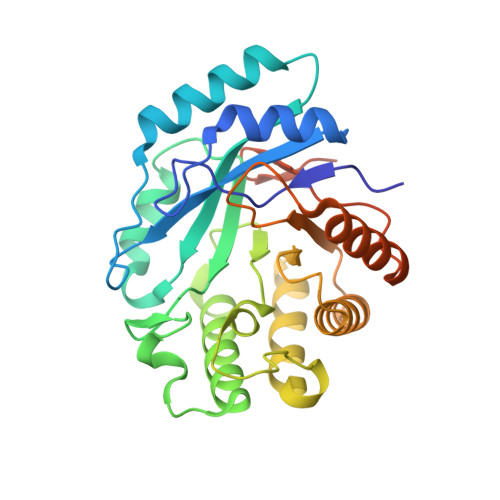Structural and Mechanistic Characterization of l-Histidinol Phosphate Phosphatase from the Polymerase and Histidinol Phosphatase Family of Proteins.
Ghodge, S.V., Fedorov, A.A., Fedorov, E.V., Hillerich, B., Seidel, R., Almo, S.C., Raushel, F.M.(2013) Biochemistry 52: 1101-1112
- PubMed: 23327428
- DOI: https://doi.org/10.1021/bi301496p
- Primary Citation of Related Structures:
4GC3, 4GK8 - PubMed Abstract:
L-Histidinol phosphate phosphatase (HPP) catalyzes the hydrolysis of L-histidinol phosphate to L-histidinol and inorganic phosphate, the penultimate step in the biosynthesis of L-histidine. HPP from the polymerase and histidinol phosphatase (PHP) family of proteins possesses a trinuclear active site and a distorted (β/α)(7)-barrel protein fold. This group of enzymes is closely related to the amidohydrolase superfamily of enzymes. The mechanism of phosphomonoester bond hydrolysis by the PHP family of HPP enzymes was addressed. Recombinant HPP from Lactococcus lactis subsp. lactis that was expressed in Escherichia coli contained a mixture of iron and zinc in the active site and had a catalytic efficiency of ~10(3) M(-1) s(-1). Expression of the protein under iron-free conditions resulted in the production of an enzyme with a 2 order of magnitude improvement in catalytic efficiency and a mixture of zinc and manganese in the active site. Solvent isotope and viscosity effects demonstrated that proton transfer steps and product dissociation steps are not rate-limiting. X-ray structures of HPP were determined with sulfate, L-histidinol phosphate, and a complex of L-histidinol and arsenate bound in the active site. These crystal structures and the catalytic properties of variants were used to identify the structural elements required for catalysis and substrate recognition by the HPP family of enzymes within the amidohydrolase superfamily.
Organizational Affiliation:
Department of Chemistry, P.O. Box 30012, Texas A&M University, College Station, TX 77843-3012, USA.
















